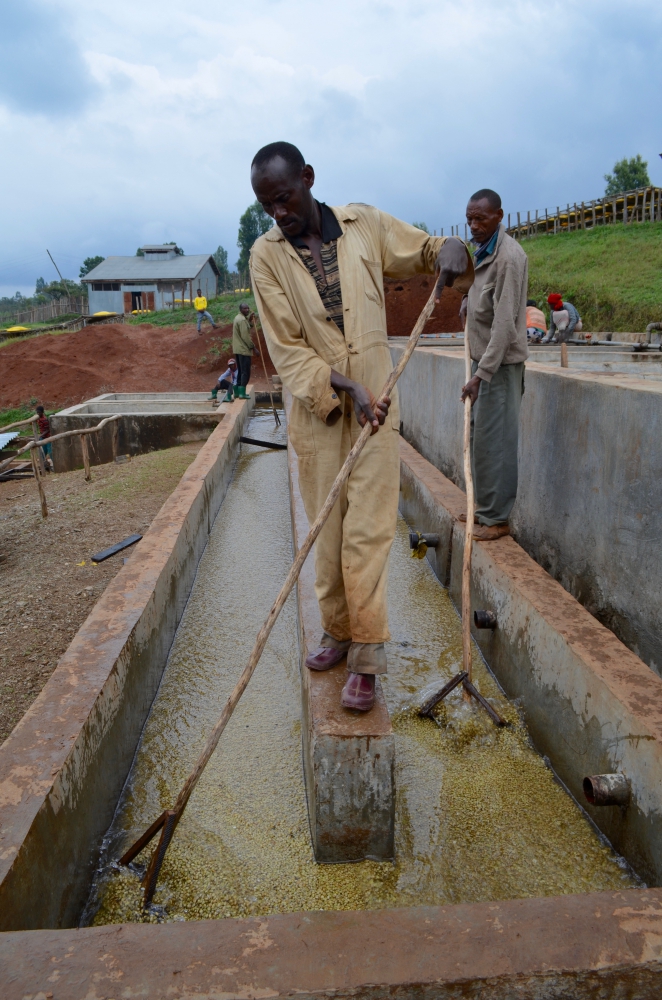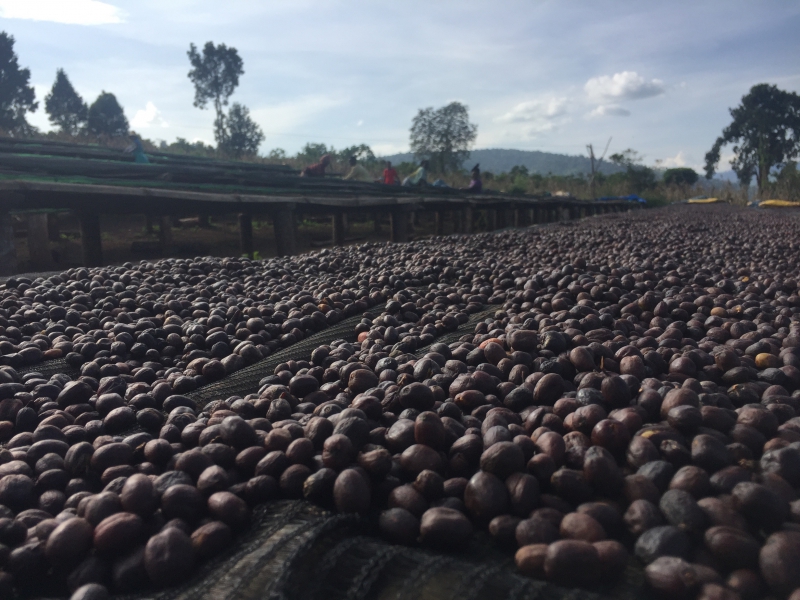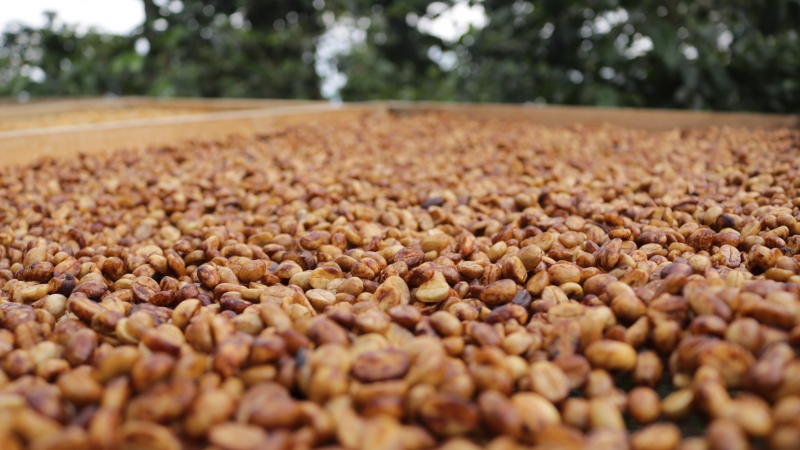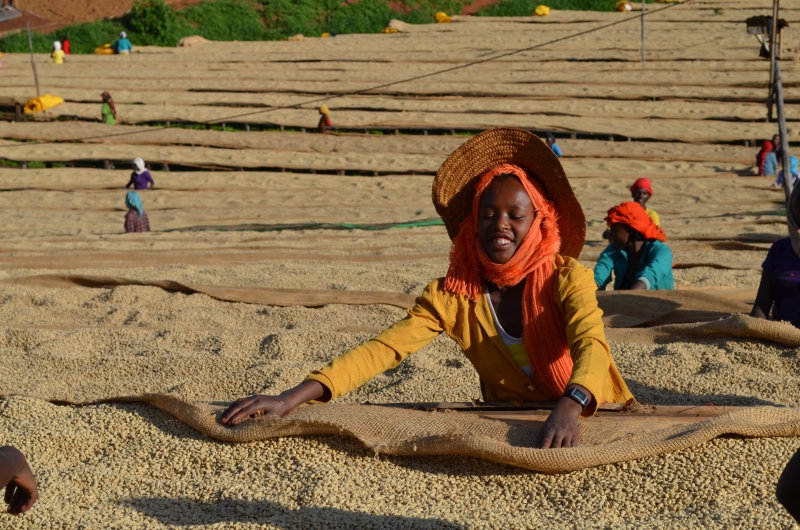The same coffee processed in different ways will reveal wildly different flavours and characteristics. Here’s why that happens. Hint: Fermentation is key!
Words by Melanie Winter
Expert knowledge by Nicodemus Nabakwe and Margaret Fundira
All images ©Coffee Magazine unless otherwise stated
Have you ever eaten an olive straight off the tree? The olive tree is a beautiful plant with floaty, inviting leaves and the olives look so very juicy hanging delicately from the tips of the branches. I can assure you, they are not juicy. Not juicy, not soft, not edible! They inspire immediate spit reflex. But by the magic of human ingenuity, and probably a lot of luck somewhere along the line, when you soak those suckers in a brine, suddenly you’ve got yourself a party. Ok, I’m exaggerating, it’s not sudden at all, it takes weeks, like up to six weeks (!!!) to get to the desired texture and flavour. What’s actually happening while the olives are in the brine is a long, slow, natural fermentation. And in fact, the process is different for green and black olives. Makes sense right? They may be the same family, but they need to be treated with different process to get the best results. And everyone likes one or the other better, I for one can’t understand why anyone would choose green over black, but that’s just me.
We just buy them in jars or in bags and it’s difficult to imagine that the tree doesn’t just produce the magic to start with. But it’s common knowledge that that’s how olives arrive to be eaten, kept moist in a brine until serving.
So what if I were to tell you that all coffee, even the washed kind (we’ll get into that later!), go through a process of fermentation. Up until fairly recently in the history of coffee this was done naturally, but with much research, the addition of yeast or microbes has increased dramatically. Ok, I’m getting ahead though. Let’s go back…
Coffee is actually an edible cherry to start off with, and it’s quite pleasant to suck the sugary coating off the coffee seeds in the hot sun, but getting it to be a drinkable beverage requires patience! And more than that, a high level of skill. The complicated process of successfully growing healthy coffee trees isn’t even half of the battle to get coffee to your cup. From the moment the ripe cherries are picked, the journey to get the best out of the seeds begins. And time is of the essence.
Nicodemus Nabakwe, a veteran of the coffee world who specialises in training people new to green coffee, explains the most widely used processing method for us: Washed Coffee

“After coffee has been harvested, it is cleaned and needs to be pulped within 12 hours. Pulping is the removal of skin and flesh of this cherry leaving mucilage (sugary substance) clinging on parchment covering the seed. This process uses water. As the beans move through washing channels, underweight beans called ‘floaters’ are separated out. Sound beans are then moved into fermentation tanks to remove the excess mucilage. After washing, the parchment coffee is spread in thin beds to dry. This is either on African raised beds or on patios. At near dry stage of within 10% - 12% moisture levels, measured using a moisture meter, parchment coffee is stored in conditioning bins ready for hulling. Hulling is the removal of parchment and silver skin attached to the coffee seed which then results in green coffee ready for roasting.”
The first method that was used to process coffee is called Natural or Sun-dried Coffee. For the very simple reason that it has zero intervention and the cherries are dried in the sun. This drying takes a lot longer than the washed coffees because there is a lot more moisture to be soaked up by the sun to get the cherries ready for hulling. It is also less expensive as much less equipment (depulper, construction of channels and fermentation tanks) and resources (water source).

For a long while this is where coffee processing stalled. Why mess with a winning formula? But in the niche of the specialty coffee world, exploration began. Remember how I said there were two styles of olives and they were processed differently? Well hold on to your hats, there are thousands of coffee varietals. It stands to reason then, that in the wonderful world of coffee with dozens of different varietals, experimentation with processing has become a big deal. Especially in the specialty coffee market where points of distinction are valued.
So now producers take the raw product, those juicy cherries from the tree and do all sorts of crazy things to them.
The gateway to a new way of doing things was Honey Processed. This posed the question, how does a different amount of sugary mucilage on the seeds effect the eventual flavour? And they started to play.

“Pulped coffee is dried in the sun. There are different honey process methods and are all dependent on amount of flesh and mucilage left covering parchment coffee after pulping, so producers wash the coffee to varying degrees but they’re not left in the channels or fermentation tanks to clean them entirely (Washed),” Nicodemus tells us, “During drying, this leaves a sticky mucilage around the seeds hence the name ‘Honey process’. White honey (less mucilage) to Black honey (more mucilage) are some examples of this. When moisture levels are near dry, the coffee is then taken for hulling to remove the husk and parchment.”
Then Sasa Šestić (World Barista Champion 2015) blew on to the coffee competition stage with a collaboration with Colombian farmer, Camilo Merizalde and whole new way of doing it. Enter the Carbonic Maceration era.
Borrowed from a technique used in wine making, harvested whole cherries are cleaned, not pulped and put in stainless steel tanks then infused with carbon-dioxide. In his Barista Championship set Sasa explained that the CO2 allows the cherries to break down different levels of pectins, often producing bright and winey coffees with strong notes of red fruits.
According to Šestić, all the flavours and aromatics produced by carbonic maceration have no way to escape. Instead, they’re absorbed by the coffee parchment, contributing to a stoned fruit quality in the cup. During the process, they use low temperatures to avoid alcohol build-up. Once the coffee has reached its desired level of fermentation, the cherries can be processed by either washing or drying. (Both processing methods are suitable for carbonic macerated coffee). They fetch higher prices in the market because of their unique flavour notes.
“The discerning drinker is always asking for new flavour notes,” says Nicodemus, “This has pushed farmers to invest in new processing methods hence a higher price for their produce. The introduction of premium naturals, honeys, anaerobic fermentation, double fermentation, and carbonic maceration processed coffees has taken everyone by surprise with their unique flavours. Some people in the industry still play it safe with traditional (washed and unwashed) ways of processing coffee. The higher prices of new processing methods hinder them from trying out new flavours, but smaller roasters are breaking this old belief that traditional processed coffees are always a winner. They have an open approach to sourcing of coffees where they explore any new processing methods that would lead to unique flavour notes. Coffee’s flavour can be developed and stretched further by experimenting with different processing methods, that have been scientifically developed. This then breaks the belief that only traditional methods work best in offering a consistent cup quality.”
The producers who are throwing their names into the specialty coffee ring in the hopes of higher premiums on their coffee, have a lot of things to take into consideration.
“In most origins,” Nicodemus explains, “especially in less advanced countries, most producers stick to traditional processing methods since they do not have capacity to try out new ways. In more advanced countries like Colombia, producers are guided by roasters who are willing to go an extra mile to offer their customers fresh options and an improved cup quality. They invest heavily in the advancement of new processing methods hence attract higher prices of their produce. The third wave in the coffee industry has always been dictated by fresh ideas in new brewing methods. These methods rely heavily on coffee processing where every drinker wants a unique taste and one that will leave a lasting experience. It is through this that we are seeing many specialty coffees flooding the market.”
So Carbonic Maceration hit the scene and it started a deluge of other thought and actual experiments about how far the boundaries of fermentation can be pushed.
Like Anaerobic Fermentation for example. The team from Cafe Imports, well-renowned global green bean import/export company, unpack this, not new, but newly popular processing method.
“This isn’t so much brand-new style of processing as it is an expansion of some principles related to the natural activity that takes place in every existing process—in fact, anaerobic-environment fermentation has been practiced for a long time in some places. The vessels in which the coffee cherries are fermented don’t contain any oxygen at all: The oxygen is removed when the coffee is added at the beginning of the process, and valves on the fermentation tanks keep them free from oxygen seeping in during the process while also allowing CO2 to be released as it builds up during fermentation.”
Keeping the coffee cherry deprived of oxygen creates a different profile that some producers value for its own sake; other producers use additives with the coffee cherries in an attempt to introduce different flavours to affect the progress of the fermentation. The latter is called anaerobic impregnation and sometimes features spices, molasses, tropical fruit, or other flavourings - controversial in the specialty community, but can be an incredible flavour experience.
Microbiologist with a strong winemaking background, Margaret Fundira, started working in coffee in 2017, with the goal of developing coffee business in yeast and fermentation giant (yes, that’s a thing!), Lallemand Group.
“Interest in fermentation in coffee is growing at a very fast pace. It’s exciting, a lot of experiments taking place and a lot of discussions around the topic!” Margaret enthuses.
To understand a bit more about what’s going on with fermentation, Margaret explains, “Coffee fermentation is the process of transforming the coffee sugars using enzymatic activities that exist in microorganisms such as yeast and bacteria. This is visually seen in coffee by the falling off of mucilage if the coffee is pulped and the release of aromatic compounds together with CO2. Microorganisms exist naturally in coffee environments. As most microbes (good and bad) need sugars as a source of energy, it is important to control our fermentation to reduce the risk that can result from an uncontrolled fermentation. Fermentation control includes: selection of microbes that are used and temperature control during and after fermentation.”
Introducing yeast to the coffee fermentation process has been essential to pushing fermentation boundaries with control, but we wondered if there had been any pushback from a notoriously particularly niche like specialty coffee?
“In my experience, people have been open minded, wanting to try the additive products and see the results they get for themselves, They would like to convince themselves that this adds value to their coffee. Once they see the value, we see producers scaling up which is really exciting. The fact that we are providing a tool that empowers producers and helps them with many benefits including the diversification of their flavour profiles, helps a lot for the Specialty Coffee world.”
Diversification of flavour is right! I have experienced my fair share of wild flavours through these processing methods, from peaches and cream (tasting the coffee black) to basil pesto (a little unsettling!).
“Use of selected microorganisms allows and enables producers to have the ‘intense’ flavours that some describe as wild. I can also add to the many benefits of coffee fermentation which include, having consistent coffee quality, avoiding microbial spoilage of coffee, better control of fermentation, improved expression and revelation of coffee flavours and reduction of water use where washed process is used.”
It certainly won’t be for everyone.

For a person who drinks coffee as part of their job, Nicodemus can attest to this, “Clarity comes to mind when choosing my coffee of the day, especially in the morning. I also tend to lean towards African naturals for my afternoon coffee. So, in this case, traditional methods do carry the day for me. I have experimented on newer processes but I find their taste a bit overwhelming.”
So when you next drink a coffee that tastes a little different that what you’re used to, perhaps spare a thought of appreciation. Think about those olives. Think about your glass of wine. Think about any food or beverage that undergoes a deliberate, carefully planned process before you consume it- giving you a significantly enhanced flavour, texture or weight that makes it the best possible version of itself, or maybe just a different take on it. After all, that’s what keeps us coming back for more.